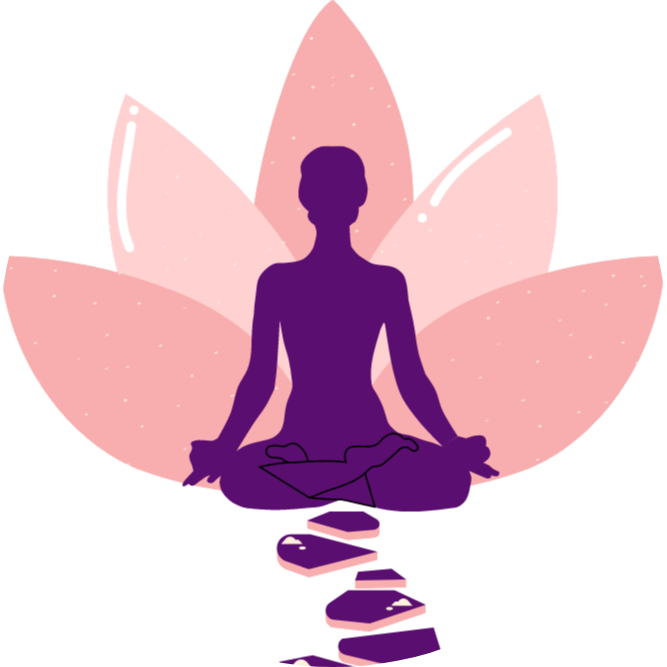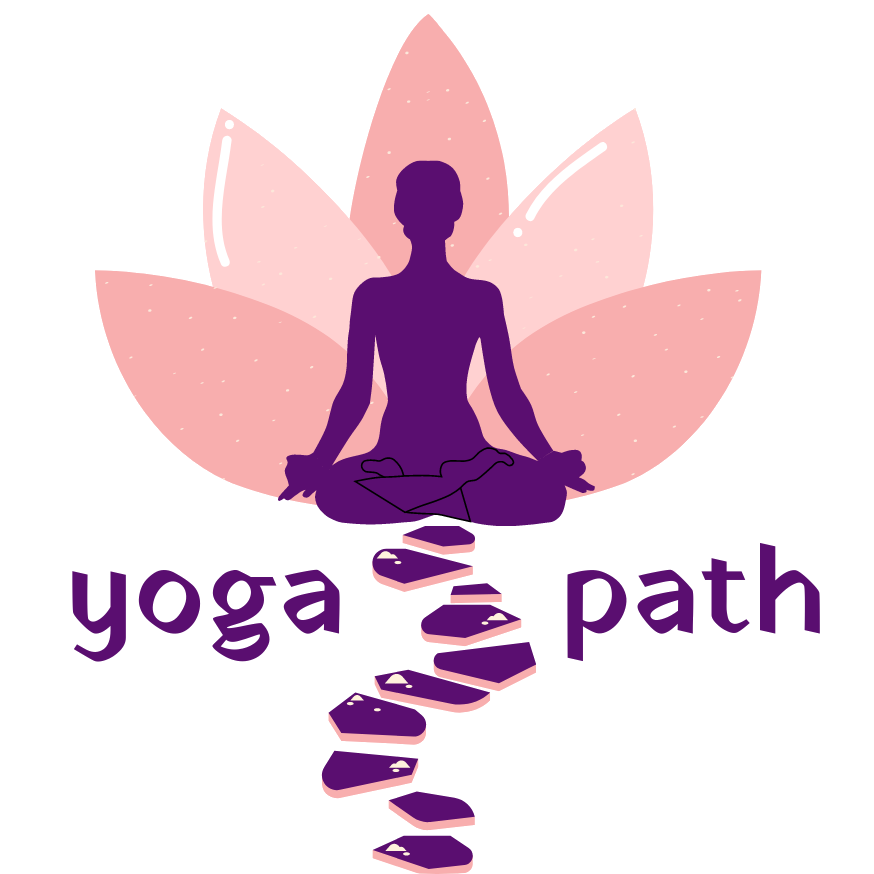Practise Yoga Asanas
Learn Asanas - Seated Poses
Seated Asanas are postures that begin with you sitting down. Sitting poses will help you improve your flexibility, strengthen your lower back, thighs, and abdominal region, and increase your stamina if you are new to yoga.
As you hold the final pose for longer periods of time, you regulate your breathing, build lung capacity, and relieve stress and anxiety.
If you find it difficult to sit up straight, raise your hips slightly by placing a folded blanket or soft pillow under your bottom.
Seated poses include straight and cross-legged postures, forward folds, and twists such as Padmasana, Sukhasana, Shashankasana, Ardha Matsyendrasana, Vajrasana, Supta Vajrasana, Paschimottanasana, Dandasana and Badha Konasana.
Paschim Namaskar
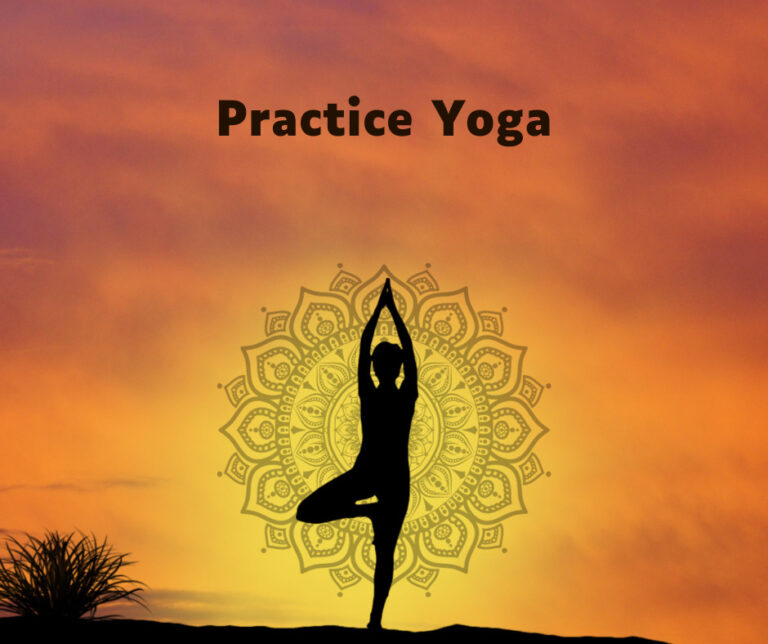
Paschim Namaskar – Seated Pose
Paschim = west, meaning backside; namaskar = greeting; asana = pose
Paschim Namaskarasana or the Reverse Prayer pose is an upper body strengthening pose that works specifically on the arms and the abdomen. It is also known as Viparita Namaskarasana.
Begin in standing Tadasana or seated comfortably on the chair or your mat. Relax the shoulders.
As you inhale bring your arms behind your back and join the palms with fingertips facing upward.
Ensure that the palms are pressed firmly against each other.
Stay in the position for a couple of breaths.
As you exhale, slowly turn the fingertips downward.
Bring the arms down to the sides and slowly come back into Tadasana or place the palms on the thighs (when seated).
Contraindications:
People with low blood pressure, arm or shoulder injury should avoid doing this pose
Benefits:
Opens the chest improves the muscles for respiration.
Improves lung capacity when used with deep breathing regularly
Stretches the upper back, the shoulder joints and pectoral muscles.
The Thoracic region of spine or upper back is very strong and helps us to stand upright and protects the vital internal organs in the chest But, this area gets limited movement, and to prevent injury or degeneration in these muscles, this asana is very effective.
Strengthens the wrists and arms as well.
Since both palms come together it has the same benefits as Anjali mudra
This asana also releases knotted up tension from your shoulders, forearms, wrists, and collarbones area. It helps strengthen your wrists and makes them flexible. Extensive typing or writing work causes pain in the wrist joints Paschim Namaskar asana, helps open and relaxes this joint. Amazing counter-pose for activities that require griping your hands. It is very effective for neck and back pain. It relieves the tightness and pain due to tension in these muscles.
Doing this asana helps in promoting digestion and also helps in maintaining your metabolism and energy levels.
It increases range of movement in shoulder, and arms.
It improves body posture. It is very effective in reducing stress and calming the mind.
A must for people suffering from negative emotions like anger, sadness, anxiety – practise ‘Paschim Namaskar Asana’ daily.
It activates and opens the heart chakra or Anahata Chakra.
Dandasana
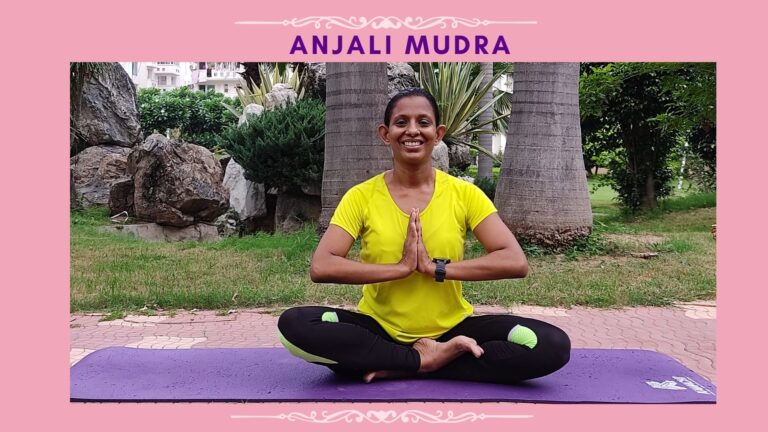
Namaskar Mudra / Anjali Mudra – Seated Pose
The gesture is incorporated into many yoga asanas. It is a Namaste, two hands folded in a welcome greeting, is the salutation that Indians are globally welcomed with. Literal meaning – ‘I salute the divinity in you.
Mudras are not just a gesture or a sign. When we are exercising, only one area of our body is being worked upon. But, when we do a mudra, it acts as a seal or bond which brings our whole body in alignment with the energy associated with the mudra. Anjali in Sanskrit means an offering to the divine. And, when we practice the Anjali Mudra, we gain several subtle benefits from it which bring us closer to divinity.
Every Surya Namaskar starts with the practitioner bringing their hands in Anjali Mudra.
For Anjali Mudra, first, sit in a comfortable position. You can sit on a chair, cushion, or in a sukhasana.
Keep your spine relaxed and lengthened. You can even tuck your chin in slightly to stretch the spine (neck).
Then, slowly bring your hands together in front of your heart chakra, the Anahata chakra. This brings your awareness to your heart, letting energy flow from other points of your body to the heart center. The hands need to be pressed evenly and firmly together.
Hold for a few deep breaths and release the palms and keep them on your lap. Repeat this process a few times.
Benefits:
When we fold our hands together, we are bringing both the hemispheres of our brain in alignment with each other. Our left brain – logical and reasoning faculties and our right brain – creative faculties. We also bring together intuition and logic, feminine and masculine, energies of our being.
Every time you bring your hands together, feel the two different aspects of your energy coming together in balance and harmony.
While you are doing the Anjali Mudra, it is important to be aware of the sensations that happen when you bring your palms together. Doing it slowly can make it easier for you to feel the vibrations. As you do it several times, notice the change in vibrations, and see if the experience changes after repeated practice.
Instills a feeling of humility, groundedness, and gratitude simultaneously.
Calms the heartbeat, improves the circulation of oxygen in the blood.
Bringing your hands together not only balances the working of the adrenal and pituitary glands, but it also gives a jolt to your intuitive capabilities.
Bringing together of brain hemispheres improves their coordination and functioning.
Practicing Anjali Mudra regularly brings more awareness, enhances concentration, and calms the mind thereby relieving stress.
Physically it improves flexibility of the arm joints and wrists.
Aside from stimulating the Anahata chakra (dealing with our emotions), the regular practice of Anjali Mudra is seen to stimulate the Ajna chakra (increases our focus and memory prowess) as well.
The human fingers are associated with the five elements that make up the entire creation. Thumb is Agni (fire), the index finger is Vayu (air), the middle finger is Aakash (space), the ring finger is Prithvi (earth), and the little finger is Jal (water). When we bring the hands together in Anjali Mudra, we also activate the elements in our bodies. When practiced regularly, these elements and all the tissues and organs associated with them also come in a balanced state.
Dandasana
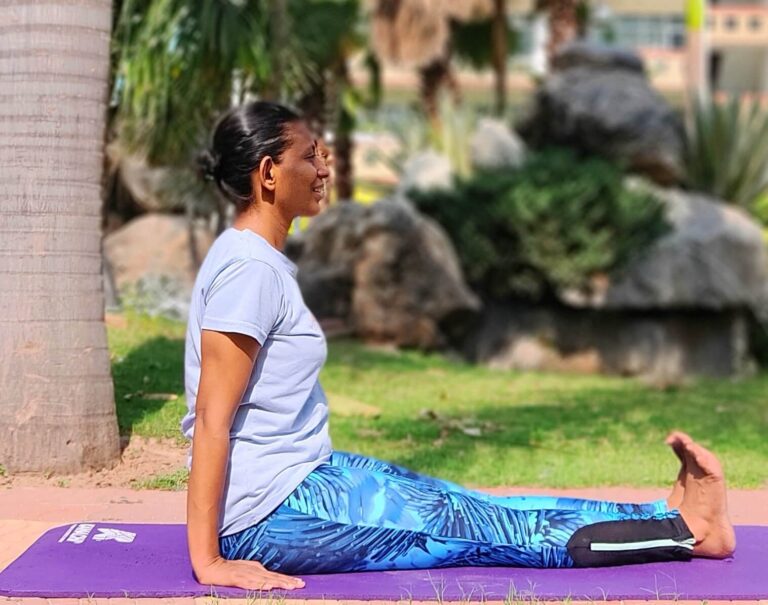
Seated Pose
Danda Asana means stick / staff pose.
In this asana, you have to keep your feet and back straight at a right angle to each other in a sitting position. This is the simplest Asana to do for all age groups.
Sit on the ground with your back straight and legs extended out in front of you. Sit on the mat and lengthen and straighten the spine. Flex your feet, press out the heels and point the toes towards you. Press the thighs down against the yoga mat and rotate them slightly toward each other.
Place your palms on the ground next to your hips, square out your shoulders yet let them be relaxed and not hunched, and expand the chest out. Sit slightly leaning forward on your sitting bones and widen them by taking hold of the flesh of each buttock and moving it out of the way.
Elongate the spine and the neck. Keep lifting from the crown of your head in an attempt to lift freely the spine towards the ceiling. If you your torso is leaning backwards, sit on a blanket or a bolster to lift the pelvis.
Press the palms firmly into the ground this will raise the hips very slightly but the spine is straight, the legs are straight, thighs engaged and knees are pressed into the ground. Broaden across the collarbones and lift the chest while rolling shoulders back and down. Draw your belly button in toward the spine.
Contraindications:
Injury to wrist or back.
Benefits:
Increase the flexibility of the hips and pelvis
stretches the hamstrings and calves while at the same time improving spinal alignment. Especially for runners (who generally have tight hamstrings).
Strengthens back muscles
Lengthens and stretches the spine
Helps considerably with back pain as it creates space and expansion between vertebra and relief from the inflammation related pain
Improves the posture
Helps blood circulation to reproductive organs
Stretches shoulders and chest
Nourishes your body’s resistance to back and hip injuries
Helps to calm the brain
With regular and consistent practice, you will gain postural alignment and awareness which in turn brings to every area of your life a fine grace and balance.
Gomukhsana

Sitting Position
Gomukhasana literally translates into a cow face posture (go – cow, mukha – face, asana – pose). A seated yoga posture, Gomukhasana can be performed along with a set of different seated asanas.
Sit on the yoga mat with your legs folded comfortably in sukhasana.
Raise the left arm above your head and bend the upper arm backward at the elbow. Simultaneously, bring the right arm behind your back from down and interlock both hands.
Take deep breaths and stay as long as you are comfortable.
Now, as you exhale, release your arms.
Beginner’s tip:
Your left hand may not be able to reach the right hand and vice-a-versa initially. In which case, do not exert too much force. With practice of holding a scarf or belt in between both hands and , slowly by inching forward toward each hand you will be able to hold both hands eventually.
Contraindications:
Frozen shoulder, Shoulder pain or injury – refrain from doing Gomukhasana. If the pain in the shoulder is not much, do the posture under the supervision of a trained yoga teacher. People with Soft tissue injury in leg such Muscle tear or pain in thighs, Bleeding piles and those suffering from Spondylitis must refrain.
Benefits:
Cures sciatica
Helps reduce high blood-pressure
Regular practice tones and massages the reproductive organs
Stretches stiff shoulders
Strengthens back muscles
Strengthens wrist and arms
Stretches spine improves posture
Reduces stress and anxiety
Stimulates kidneys and abdominal organs
Strengthens muscles of ankles, hips, thighs, shoulders, triceps, inner armpits and chest.
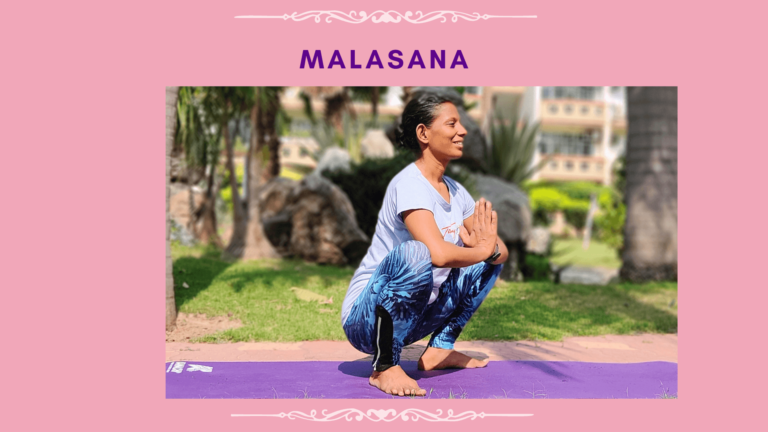
Sitting Position
Malasana meaning Garland Pose
In this asana, squat with your feet as close together as possible. Keep your heels on the floor if you can; or support them on a folded mat.
Open out your thighs slightly wider than your torso. Exhaling, lean your torso forward and fit your elbows snugly between your thighs.
Press your elbows against your inner knees, bringing your palms together in Anjali Mudra (Namaste) – this will help lengthen your front torso.
Hold the position for 30 seconds to 1 minute, then inhale, straighten the knees, and stand up.
Benefits:
Strengthens pelvic floor Increases circulation to the pelvic region benefiting those suffering from PCOS – this mostly on the legs, especially on the hips and thighs Enhances the flow of blood and ensures good elasticity in your hips, thighs, groin and ankles Opens hip flexibility and strengthens leg muscles and increases flexibility Tones the abdominal muscles and improves the function of Colon to help with the elimination of waste Increases circulation and blood flow in the pelvis helping in regulating hormones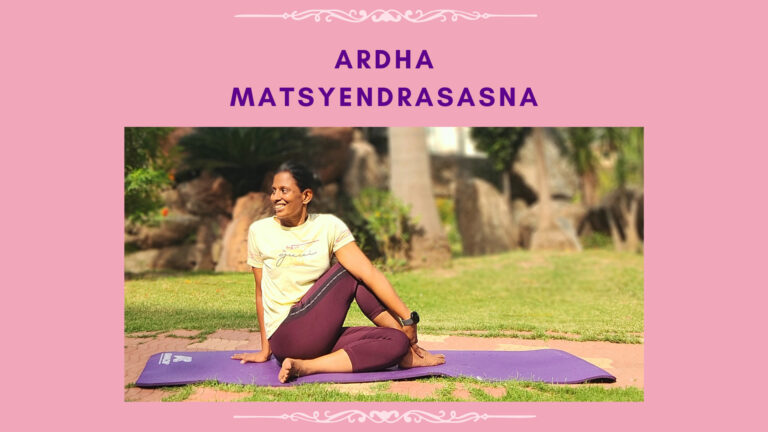
Seated Pose – Half Spinal Twist
Ardha Matsyendrasana is named after Rishi Matsyendranath who was a Hatha Yoga proponent and his favourite meditation asana was a full spinal twist itt was simplified so that everyone could also practise which we know as Ardha Matsyendrasana.
In this asana, sit on the mat with the legs stretched out straight in front of you, keeping the feet together and the spine erect. Bend the left leg, place the left heel beside the right hip. Take the right leg over the left knee place the right foot close to the left knee. Place the left hand on the right knee and the right hand behind you. Twisting the waist, shoulders and neck to the right look over the right shoulder. Keep the spine extended straight and erect. Hold while breathing in and out. Release the right hand first (the hand behind you), unwind the waist, then chest and the neck and sit up relaxed and straight. Repeat on the other side.
Contraindications:
Hernia, peptic, ulcer and severe spinal problem, as well as people who went for abdominal, heart or brain surgery. Pregnant women should not twist.
Benefits:
Increases the elasticity of the spine makes it supple which further help to relieve stiffness between the vertebrae and prevent back pain.
Benefits people with a mild slip disc problem.
Opens the chest and increases the oxygen supply to the lungs.
Helps to increase the digestive secretions by opening the chest.
Helps to strengthen abdomen, chest, spine, arms and hips
Loosens up the hip joints by relieving stiffness.
Increases the blood circulation to the pelvic region as well as enhance the functions of the reproductive system.
Helps heal piles and fissures due to good blood circulation.
Helps to prevent menstrual disorders and urinary tract related problems.
Helps relieve diabetics. The deep stretch and intense breathing work activates the pancreas by massaging and stimulating it.
Parvatasana
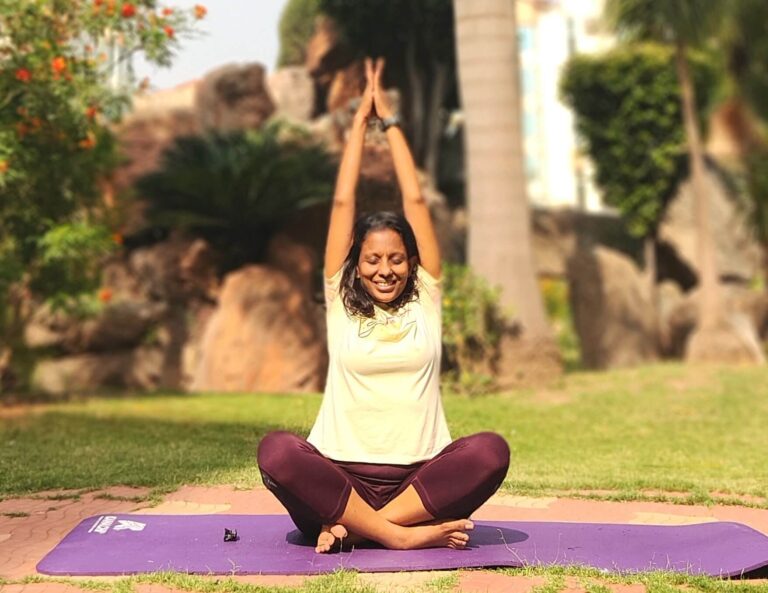
Seated Pose
Sit in Padmasana / Sukhasana, keeping the hands at their respective sides, and keeping the spine and neck straight, shoulders squared out, focus on a single point straight ahead.
Classical Pose:
Inhaling, in 3 seconds, raise both the arms together, from their respective sides, for an upward stretch. Join the palms to each other in this upward stretched position of arms. Either interlace the fingers or keep the palms joined. Keep the arms close to the ears, arms straight at the elbows and wrists. Maintain this position for 6 seconds, . Return to starting position exhale, in 3 seconds, turn the palm outwards and lower the arms straight down to the sides to complete 1 round. Practice 4 rounds.
Benefits:
Corrects minor postural defects of the spine and straightens the muscles of the back
Stretches all the abdominal and pelvic muscles and opens the hip joint
Exercises the waist zone, and reduces belly fat and flabby abdomen
Internal organs in the abdominal region get a massage and good blood circulation
Prolapse of the uterus is improved by providing natural support to the viscera
Blood circulation in the vertebral region improves, and the efficiency of the nerves coming out of the vertebra is improved
It reduces mental fatigue while improving memory and concentration by increasing blood circulation to the brain
The unnatural curvature of the spine and minor displacements of the vertebrae are corrected
Vajrasana

Seated Asana
Vajrasana Asana meaning Thunder Bolt Pose
This yoga posture has been named after the shape it takes – that of a diamond or thunderbolt. One can sit in Vajrasana at the time of doing pranayamas.
Assume a kneeling position on a mat with your knees touching each other. Let your toes touch each other and the heels remain apart. Lower your body and sit comfortably in the space between your toes and heels. Place your hands upon your knees with your palms facing downwards.
Close your eyes and passively observe your breath or keep your gaze fixed at one point. Sit for around 5 to 10 minutes.
Contraindications:
Acute arthritis and very high or low blood pressure.
Benefits:
It stretches the thighs, calves, ankles and hips.
It stretches the spine, corrects postural defects.
It improves blood circulation to the abdominal region thus helping improve digestion
Alleviates sciatica or severe lower back problems or constipation or stomach disorder or digestive problems or acidity
Hence with improved digestion and assimilation hairfall is greatly reduced
Flexibility of the lower limbs
The generative organs are toned
It provides relief from urinary problems.
This posture calms the mind and relaxes the nerves.
If you want to put pressure on Surya Nadi allow the left toe to rest on the right toe
If you want to put pressure on Chandra Nadi allow the right toe to rest on the left toe
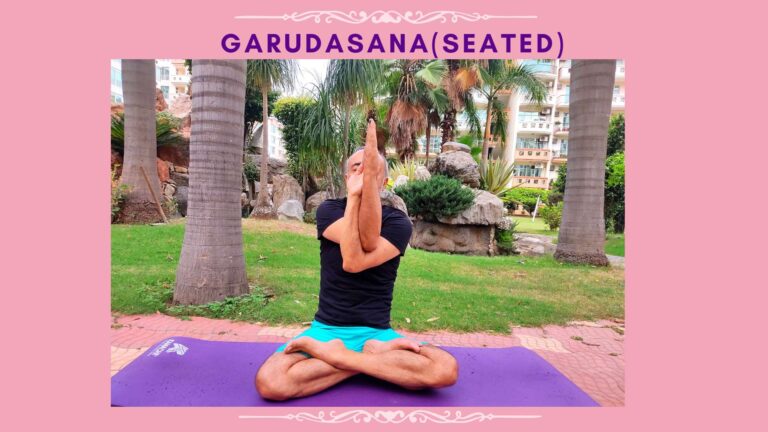
Seated Pose
In Sanskrit, Garuda is the name of the eagle which is the vehicle of Lord Vishnu. In the seated eagle pose, the two arms are brought together and the two fore-arms are twisted together. It gives a good stretch to the arms and the shoulder muscles.
I this asana, sit in a comfortable position on the floor with arms resting on the thighs. Sukhasana or the Easy Pose can be assumed by sitting cross legged on the mat. You may also do this sitting on a chair. Take the right arm under and around the left arm and make the right palm touch the left palm. At this point the two arms are inter-twined together like two snakes.
Keep the spine straight and relax the shoulders. Look straight ahead and breathe normally in this position. Hold the position for as long as you are comfortable.
To release the position, untangle the arms and bring the arms back to the thighs.
Repeat the same with the left arm twisting around the right arm.
Contraindications:
Elbow wrist shoulder injury
Benefits:
Stretches the joints of the wrists, elbows and shoulders.
Improves the posture of the upper back.
Straightens the spines and posture.
Removes stress from the shoulders and the lower neck region.
Opens up the shoulders and chest. It helps with stiff shoulders
Seated Garudasana is easy to practise and can be done anywhere – in the office or even while travelling. Just a minute of seated Garudasana can give a good stretch and relaxation from the stress built up in the shoulders.

Forward Bend & Backward Bend
Marjari meaning Cat, Bitila meaning Cow
In this asana, sit in Vajrasana then come on all fours or table top with with knees and palms on the floor. The palms are at shoulder distance on the floor also the knees and feet are at hip distance apart. The palms are directly under the shoulder with arm perpendicular to the floor and the knees are under the hips. Look straight ahead. As you inhale, raise your chin, tilt your head and chest back pushing the palms firmly into ground push your navel downwards and raise your tailbone. Hold this cat pose and take long, deep breaths.
Follow this by Bitilasana, a counter pose: As you exhale, drop your chin to your chest and arch your back up as much as you can; pull in the pelvic and chest to form a curve in the spine. Hold this pose for a few seconds.
Contraindications:
Weak wrists injury or surgery to wrists
Shoulder injury back injury
Weak or injured knee – use padding under knees
Benefits:
Brings flexibility to the spine
Stretches the back and relaxes it
Stretches the scapula out and in and increases mobility
Strengthens lower back
Strengthens wrists and shoulders
Massages the digestive organs and improves digestion
Tones the abdomen
Relaxes the mind
Relieves menstrual pain
Improves focus
Improves blood circulation
Badha Konasana
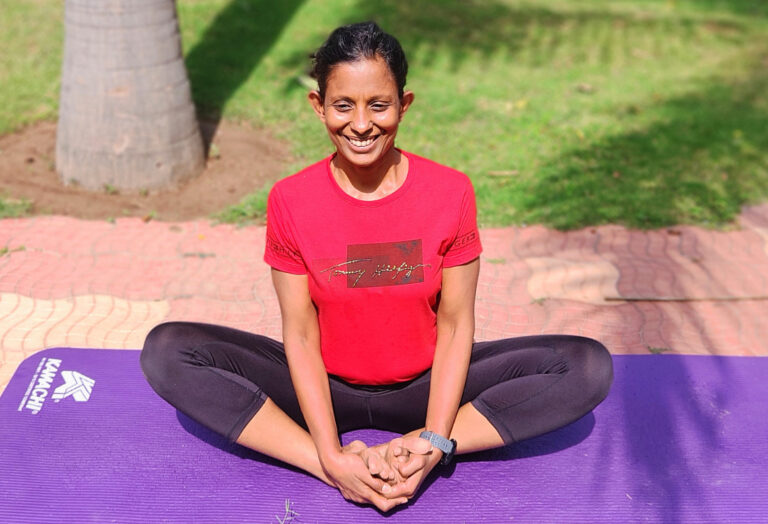
Sitting Posture
Badhakonasana is Butterfly Pose
Sit on the mat with the legs fully stretched forward, toes together – pointing upwards in Dandasana.
Keep the hands beside the body, palms resting on mat.
Inhaling, in 3 seconds, draw both the legs close to the body, with the knees bent outward and the soles of the feet coming together.
Bring the the heels touching each other close to the perineum.
If required, clasp the feet to bring the heels as close to the body as possible.
Now, place the hands on the respective knees pressing them down. Keep the upper part of the body and the neck erect. Hold this pose for 6 seconds.
Exhaling, in 3 seconds, slowly stretch out the legs in front. Practice 3 – 4 rounds.
You can hold the pose for 1 minute and increase slowly. If your legs feel numb or start feeling discomfort, gently release the posture.
Contraindications:
Severe Arthritis and Knee injury
Benefits:
Increases flexibility in joints and in the muscles of the pelvis, knees and ankles.
Stretches both the superficial and deep muscles of the inner side of the thighs.
The interior of pelvis, groin and reproductive organs are stimulated and benefitted.
Those suffering from PCOS are benefitted
urogenital region and groin region receive good circulation.
Relieves tension in the sacral and coccygeal regions of the spine.
Relief in cases of sciatica, varicose vein and menstrual disorders.
Improves posture and concentration–mind remains focused and relaxed.
It opens your hips flexibility and strengthens your leg muscles and increases flexibility.
Mandukasana
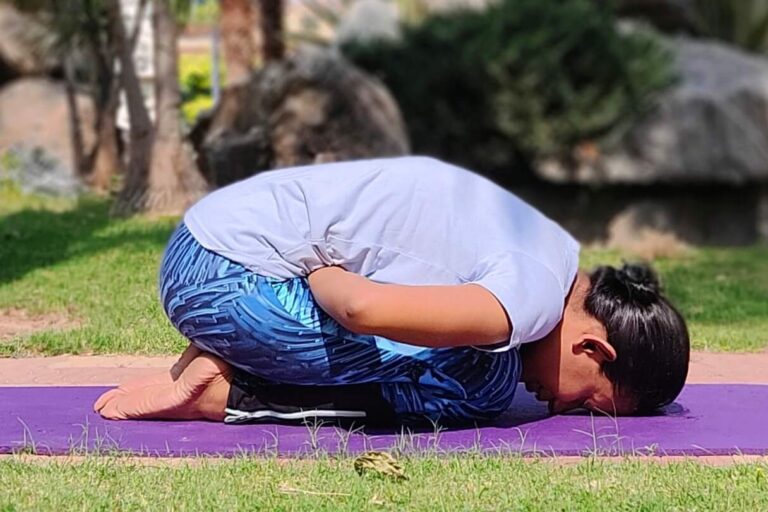
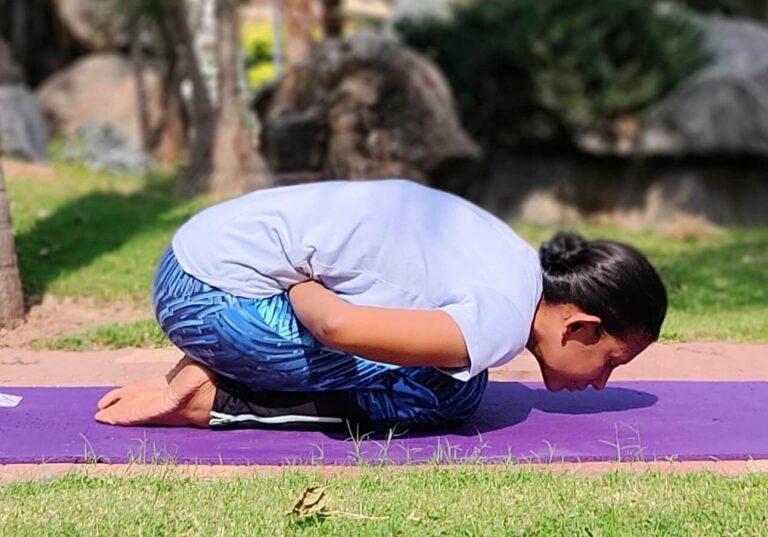
Seated Asana – Forward bending
Manduka meaning Frog
- In this pose, as you inhale in 3 seconds, form a fist folding the thumb inside the fingers and place it below and on both sides of your navel with elbows pointed out.
- As you exhale in 3 seconds, extend the spine, raise the chest upwards and then lower the torso down. In doing so, the fists are pressed deep in the abdomen in the navel area, the fists are still standing on either side of the navel.
- Lower the head down as much as you can to the floor without lifting thighs off the heel.
- Hold this pose for 1minute.
- Slowly you can increase to 3-5 minutes
Contraindications:
People suffering from Peptic or Duodenal Ulcer, severe Back Pain and Cardiac problem, abdominal surgery should avoid this exercise.
Knee pain patients, those with ankle injuries,
High blood pressure, Insomnia, Migraine and pregnant women should refrain.
Benefits:
This pose is beneficial to all organs of the body.
Relief from diabetes, digestive disorders and constipation.
Improves the flexibility and mobility of the knee and ankle joints.
Tones muscles of the shoulder and abdomen.
Regular practice of this pose increases your lung capacity.
Beneficial for people suffering from ailments of the pancreas and the heart.
Helps reduce fat from thighs, belly and hips.
Ushtrasana

Sitting Position – Backward Bend
Ushtrasana meaning Camel Pose
Sit in Vajrasana then come into a kneeling position on the mat.
Slowly, lean backwards, and take the arms behind.
Place the palms on the heels.
Keep the arms straight, inhaling in 3 seconds, slowly lift the pelvis and chest upward and outward. Allow the neck to fall backwards gently. Slowly maintain the final position for 30 seconds to 1 minute. Breathing should be normal – slow and rhythmic. Exhaling, in 3 seconds, gently draw back the torso and straighten the neck. Releasing the palm, come back to kneeling position. Practice 2 rounds.
Contraindications:
Abdominal inflammations, Ulcers and Slip Disc
Benefits:
Stretches back shoulder and neck.
Stretches thighs, abdomen, thorax, neck and facial muscles.
Alleviates constipation.
Relieves back pain.
Improves posture by correcting drooping shoulders and rounded back.
Improves breathing by opening up the chest; hence, good for asthmatics.
Stimulates and regulates ovaries, thyroid and other glands.
Improves stamina and self esteem.
